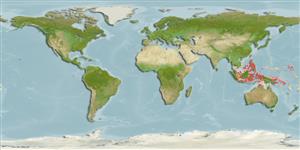Teleostei (teleosts) >
Ophidiiformes (Cusk eels) >
Dinematichthyidae (Viviparous brotula)
Etymology: Diancistrus: Greek, di = two + Greek, agkistron = hook (Ref. 45335); karinae: Named for Karin Bloch, wife of Jørgen Nielsen.
Eponymy: Karin Bloch is the wife of the third author, Jørgen Nielsen, who thanked her for her “most valuable support” during the many hours he invested in the study of this genus. (Ref. 128868), visit book page.
More on authors: Schwarzhans, Møller & Nielsen.
Environment: milieu / climate zone / depth range / distribution range
Ecology
Marine; benthopelagic; depth range 0 - 16 m (Ref. 57884). Tropical
Western Central Pacific: from the Philippines to the northern tip of Sulawesi (Indonesia) in the west and the oceanic islands of Palau, Pohnpei (Micronesia) and Hermit (PNG) islands in the east.
Size / Weight / Age
Maturity: Lm ? range ? - ? cm
Max length : 7.5 cm SL male/unsexed; (Ref. 57884); 8.2 cm SL (female)
Short description
Identification keys | Morphology | Morphometrics
Dorsal soft rays (total): 78 - 83; Anal soft rays: 61 - 68; Vertebrae: 43 - 46. This species is characterized by the following: Vertebrae 11-12+32-35=43-46, dorsal fin rays 78-83, anal fin rays 61-68; very large eyes (2.7-3.8% SL), D/V 7; outer pseudoclasper large, about 1 1/2 length of inner pseudoclasper, wing-shaped, flat and its posterior part strongly bent backward; inner pseudoclasper joined to outer pseudoclasper anteriorly, long, single-pointed tip strongly extending over anterior part of inner pseudoclasper; scale patch on cheek with 5-6 scale rows on upper cheek, large scale patch on operculum continuous above and below opercular spine; head high, usually high-necked; otolith length to height ratio 2.0-2.1 (Ref. 57884).
Solitary inhabitant of coral reef crevices to at least 16 m depth, cryptic (Ref 90102).
Life cycle and mating behavior
Maturity | Reproduction | Spawning | Eggs | Fecundity | Larvae
Schwarzhans, W., P.R. Møller and J.G. Nielsen, 2005. Review of the Dinematichthyini (Teleostei, Bythitidae) of the Indo-West-Pacific. Part I. Diancistrus and two new genera with 26 new species. The Beagle, Records of the Museum and Art Galleries of the Northern Territory 21:73-163. (Ref. 57884)
IUCN Red List Status (Ref. 130435: Version 2024-1)
Threat to humans
Harmless
Human uses
Fisheries: of no interest
Tools
Special reports
Download XML
Internet sources
Estimates based on models
Preferred temperature (Ref.
123201): 28.4 - 29.3, mean 28.9 °C (based on 944 cells).
Phylogenetic diversity index (Ref.
82804): PD
50 = 0.5000 [Uniqueness, from 0.5 = low to 2.0 = high].
Bayesian length-weight: a=0.00389 (0.00180 - 0.00842), b=3.12 (2.94 - 3.30), in cm total length, based on all LWR estimates for this body shape (Ref.
93245).
Trophic level (Ref.
69278): 3.3 ±0.5 se; based on size and trophs of closest relatives
Fishing Vulnerability (Ref.
59153): Low vulnerability (10 of 100).
